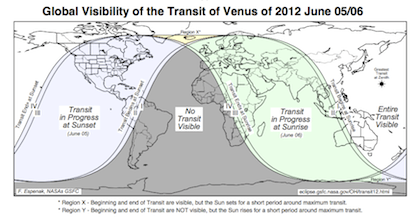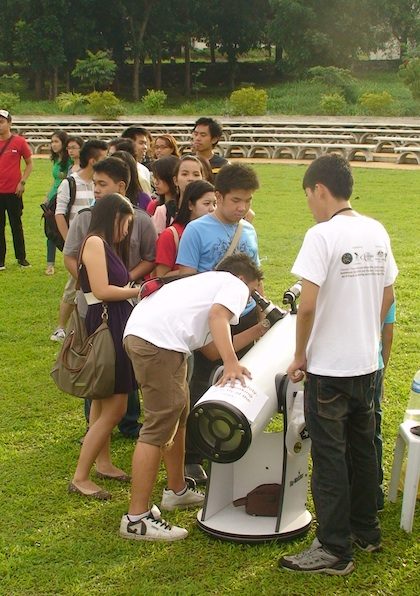SUMMARY
This is AI generated summarization, which may have errors. For context, always refer to the full article.
MANILA, Philippines – It’s more fun in the Philippines, indeed, as it proved to be a lucky place to be in on Wednesday, June 6. The country was one of the few areas where the Transit of Venus was visible in all its entirety.
A rare astronomical occurrence, the Transit of Venus has our neighboring planet appearing as a black dot as it travels against the luminous surface of the sun. This year’s event was preceded by a transit 8 years ago, in 2004.
After occurring twice within a span of 8 years, The Transit of Venus occurs again in December 2117, or more than a hundred years later. This will be followed by another occurrence in December 2125.
In an astronomy fair entitled, “Rekindling Venus,” (while the Venus transit was in motion), National Institute of Physics professor Jose Perico Esguerra explained the situations for which a transit should be visible from the Earth’s point of view.

He said that Venus must be positioned directly in between the Earth and the Sun. Furthermore, the orbital plane of both planets must also be aligned – a rarity, given an inherent 3.4-degree difference in the tilt of their orbital planes.
“Because of this difference, for us to see a transit, not only should Earth and Venus have the same angular positions, the two planes should also ‘coincide,’” Esguerra told astronomy enthusiasts.
“Exact alignment is very rare. In these very rare circumstances, we have a transit.”

He also said Filipinos are fortunate to observe the phenomenon from the first point of contact to the last. Seen in the map above, Venus will start being visible to some areas even before the sun rises.
For other areas, the sun will have set before Venus completes its transit – the case for the Philippines during the last transit in June 2004. Unfortunately, some regions will experience the complete transit during nighttime, rendering Venus invisible to them.
Bringing astronomy down to earth
Esguerra’s lecture was part of the astronomy fair held at the UP Diliman College of Science Amphitheater. Organized by the UP Astronomical Society (Astrosoc), the UP Los Baños (UPLB) Astrosoc, and the Rizal Technological University (RTU) Astrosoc, the event opened the doors of the galactic phenomenon once reserved for professional astronomers to the interested public.
Telescopes were scattered around the grassy fields of the amphitheater, with event attendees free to peek at the voyage of the 2nd closest planet to the sun as it traveled across the giant star. There were also astrophotography booths, meteorite exhibits, and a mobile planetarium to complete the whole experience of astronomy, while the participants waited for the transit to fully commence.

“The transit goes on for 6 hours, we can’t have everyone observe for that long time,” Dean Galapon, co-founder and former president of UPLB Astrosoc, said in Filipino. “The idea was to make the entire fair as interactive as possible.”
While the venue had an exclusive area for professional astronomers to record the transit activities, what was important to the organizers was to bring the highly technical field of astronomy to a wider audience.
“We do these with astronomical events because they are rare and more of the public are actually interested in them,” added Galapon. “Part of the goal is to disseminate information to the public.”
The event was well received and well attended by those whose interests were sparked by the transit. While the program was scheduled to start at 7:30 am, eager attendees were on site as early as 6:00 am to coincide with the first contact of the planet and the sun. Participants stayed until the final contact, which occurred a few minutes after noontime.
Historical and astronomical
While the rest of the world immortalized the unique galactic event, a country off the southern coast of the Pacific Ocean had more to celebrate for the transit – its discovery.
In her speech, Australian embassy senior public affairs officer Mariel Eduarte said that during the latter half of the 18th century, Captain James Cook responded to a call for “global scientific cooperation” for exploration and other scientific research. Cook’s ship was the only one to voyage to the Pacific, in hopes of calculating the distance of the Earth to the Sun. A year later, he discovered the east coast of what is now known as Australia.
“The Transit of Venus will always be close to Australian history,” Eduarte told the attendees.
The Australian embassy served as partner as part of their “Scientists in Schools” initiative, a program designed to promote science education and research across different campuses. As part of the fair, the embassy gave talks on protecting the coral reef, as well as science education opportunities in Australia. – Rappler.com
Click on the links below for more.
Add a comment
How does this make you feel?
There are no comments yet. Add your comment to start the conversation.